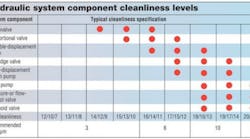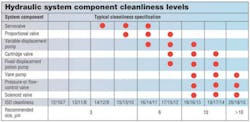Do you want your power unit to last a lifetime? Of course you do. . . but how? You can improve system life simply by keeping its hydraulic fluid cleaner. For example, if you improve fluid cleanliness from an ISO (International Standards Organization) level of 22/21/18 to 16/14/11, component life increases approximately seven times!
Clearances of many hydraulic components are within ten-thousandths of an inch. Consistent operation and reliability can only be achieved with clean fluid, which comes from keeping dirt out of the system and strict filtration. In most, if not all cases, dirt that causes problems in these applications can't even be seen without magnification.
For example, a human hair, with a diameter of about 70 µm, is near the lower limit of most people's vision. However, contaminants that must be removed for critical applications can be smaller than 16, 6, or even 4 µm — less than 1/10 the diameter of a human hair. Contaminants in this size range are covered in ISO 11171.
Many methods exist to quantify particulate contamination, but the most prevalent standards for mobile and industrial hydraulic applications are published by ISO. ISO 11171 relates to the number of particles that are greater than or equal to a given size. For example, in an ISO range 16/14/11, the first two digits (16) refer to the number of particles equal to or greater than 4 µm in a sample. The next two digits (14) refer to particles equal to or greater than 6 µm, and the last two digits (11) refer to particles equal to or greater than 16 micron. ISO 11171 replaced ISO 4406, which referred to 2-, 5-, and 15-µm sized particles.
Is Fluid Clean Enough?
The illustration shows recommended guidelines based on the type of hydraulic components used on a power unit. This type of information helps you determine how clean the hydraulic fluid needs to be. However, how do you know if the cleanliness of your fluid meets the requirements of a specific cleanliness level? The best results can be achieved by using an on-line particle counter, which typically gives results consistent with either ISO or NAS standards. An alternative to using a particle counter is to obtain fluid samples for analysis by an independent laboratory.
Results from a particle count or test lab will reveal the concentration and size distribution of particles found in the fluid sample. This, in turn, refers to the Beta ratio of the filters. Absolute Beta ratio refers to a filter's effectiveness at capturing particles of a minimum size. For example, if a filter has an absolute Beta 10 rating of 200, for every 200 particles sized 10 µm or larger enter the filter, only one will exit. This standard is not applied to nominal rated filters.
What Type of Filter?
Once you've determined the required cleanliness of the fluid, and how clean — rather, how dirty — it is, what kind of filter should you install on the hydraulic power unit? This simple question has a complex answer, so let's start with the pump.
A suction filter (sometime called a suction screen or strainer) is the starting point. A suction filter protects the pump by keeping it from drawing in large particles, such as like nuts, bolts, tie wraps, etc. However, if the suction filter becomes clogged, flow to the pump can be restricted. This can cause serious pump damage from cavitation, which occurs when air enters the pump. Be especially mindful of this when sizing on any suction strainer to avoid cavitating the pump.
Suction filters are not intended to be a primary means of trapping dirt. They usually consist of a simple screen mounted in the tank, to the bottom of the supply tube leading to the pump, or mounted to the reservoir wall. Another type has a head with a shut-off valve, which is particularly useful for large reservoirs — allowing the filter element to be changed without draining fluid from the reservoir.
Many Happy Returns
A primary type of filter for power units is a return-line filter — typically the most cost-efficient choice. They are effective because all fluid returning from the hydraulic system must pass through them. In-tank or top-of-tank mounted filters come in a wide variety of sizes and styles. Filters that bolt to the top of the tank minimize connections and potential leak points. They come with bypass valves (typically set for 25 psi) and are offered with optional built-in breathers, drop tubes to minimize foaming, and dipsticks to check fluid level.
Line-mounted return filters are manufactured in two distinctive styles — one where fluid flows outside to in, and another where fluid flows from inside to out. Filters with an outside-to-in element are the less expensive of the two. However, when the element of an inside-to-out filter is changed, the element and all the dirt it has trapped comes out. Plus, magnets can be placed in the element to trap ferrous particles smaller than what the element can capture.
Another type of in-line return filter is the spin-on type. It has a head and a metal can similar to what is used on cars. They are readily available and inexpensive. However, they easily can be replaced with an element that has a much poorer rating. For example, a power unit may be initially supplied with a filter with an absolute rating but replaced with a cheaper filter that has only a nominal rating.
Performing Under Pressure
Pressure filters typically are mounted in-line upstream of sensitive components or on pilot lines to protect critical components, such as servovalves. This is the only way to remove dirt — such as wear debris — generated within the hydraulic system itself. Pressure filters usually are recommended for high-pressure systems because they are much less expensive than the components they protect.
They come with or without bypasses, and may even have a reverse-flow feature. This consists of a check valve in a parallel fluid route so that only fluid flowing to the servovalve is filtered. Fluid from the servovalve flows past the filter. This essentially doubles the life of the filter because it filter half the fluid of a non-reverse flow filter.
Getting in the Loop
Off-line filtration, often called a kidney loop, uses a low-pressure pump to draw dirty fluid from a reservoir, filter the fluid, and return it to the reservoir. This often occurs even when the hydraulic system is not running.
Off-line filtration occurs with fluid flowing at a constant rate — the most effective method of filtering. The strategy is to get the fluid in the reservoir as clean as possible, which will ease the burden of other filters in the hydraulic system.
When supplied with quick-acting couplings and wheels, a self-contained off-line filtration system becomes a filter cart that can be used on multiple machines. This presents an economical way to clean the fluid of many machines by connecting the filter cart to one machine, filtering the fluid until it is clean, then connecting the filter cart to another machine.
Not to be Overlooked
But perhaps the most good can be done for the least amount of money by using a filter-breather. Filter breathers prevent large amounts of dirt from entering the reservoir from the surrounding air. A good design practice is to use a minimum of a 10-µm rated filter. For humid environments, you should also consider using a breather that can remove moisture. Breathers with a built-in supply of desiccant accomplish this.
Another option is to isolate the system completely from the environment. A simple and inexpensive way to do this is with an air bladder. The bladder allows air to enter or exit the reservoir, but because it stays in the bladder, the air does not come in direct contact with the fluid — nor do the moisture and other contaminants contained within it.
Finally, realize that fresh hydraulic oil typically has an ISO rating of about 22/20/18, which can be more contaminated than the oil in your existing system. Therefore, filter the oil before adding it to your system.
For more information, contact Tony Grythe, of MP Filtri USA at (215) 529-1300, email [email protected], or visit www.mpfiltriusa.com.
(This article appeared in print as "Give That Power Unit a Life Sentence.")



